The Bird Cage...Home and Hearth
Birds live most of their lives in cages. Those cages are kept in our homes. So, they live in a cage within a larger cage, so to speak. Most bird owners pay a lot of attention to arranging and setting up their bird's cages to provide an interesting and stimulating environment, much like we organize, decorate and set up OUR “cages” for ourselves.
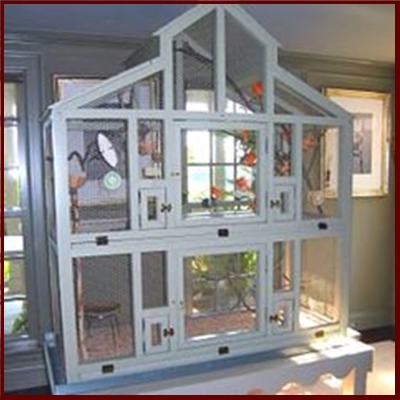
Ideal setup for a whole bunch of finches. Or canaries, or budgies, or cockatiels, maybe a half a dozen conures. There would be much singing, sweet to the ear.
So, let’s talk about “environments.” That is…the cage, its “furniture,” its arrangement and layout. There’s a lot more to keeping a bird happy than just throwing it in a cage with a couple of dishes and a perch to stand on.
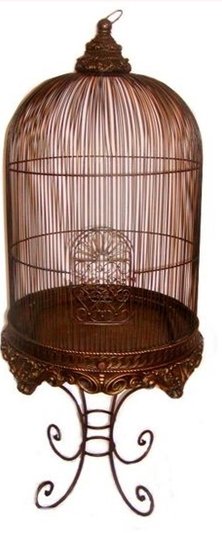
NEVER! Not for any bird of mine. Nope. Not ever!
Consider the inside of your bird’s cage as you would consider your family or living room. You’ve arranged the flow in your family room. You’ve put the furniture in your living room into a pleasing arrangement. There's pictures on the walls, curtains on the windows. In short, your living space is as friendly and as attractive as you can make it.
Why would you do any less for your bird? Unfortunately, many people just don’t think about their bird’s living quarters in the same way they look at their own spaces. When you consider that your bird may spend ALL its time, at least a large percentage of it INSIDE the cage, that environment should be as “bird-friendly” as possible. It should have several well thought out objectives and the arrangement should allow those goals to be met.
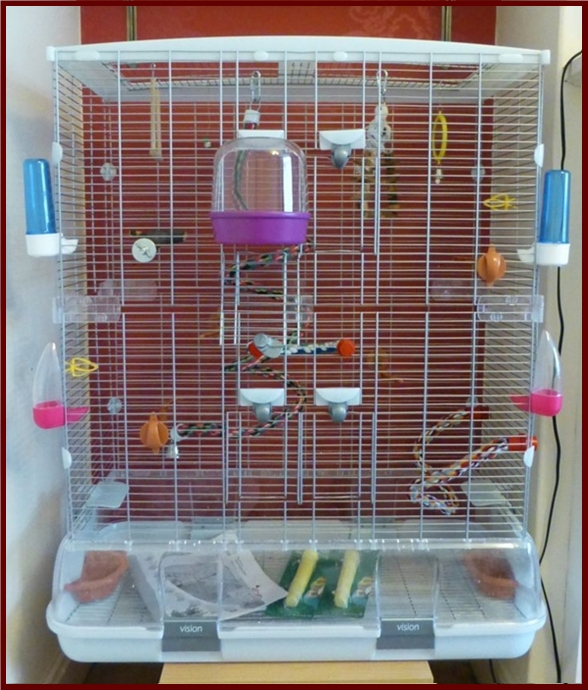
Nice digs for a couple of parakeets. Best near a window, no drafts. Quiet and dark at night.
That’s a long way of saying you need to set up the “living quarters” for your bird with some of the same care you used on your own spaces.
What does a bird truly NEED in its environment? Obviously, easy access to food and water is the most important. But, you should pay attention to placement. You don’t want a water dish in a location where the bird routinely poops, for example. And you wouldn’t put a food dish behind a heavy hanging toy that the bird has to move or maneuver around to get to its food. Common sense stuff, but you’d be amazed at how little thought some folks expend when setting up a cage from the bare wire bars to finished quarters.
So…let’s do that. Set up a cage for a bird.
Obviously, the SIZE of the cage is the first order of business. How big should it be? The universally quoted maxim is, “As big as you can afford.” Well, that’s a good generic guideline, but it doesn’t do much to DEFINE the cage or its space.
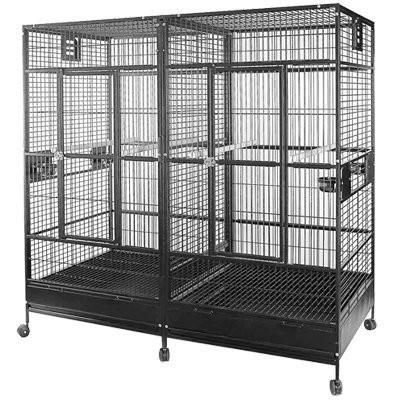
This was my "outdoor cage" in Florida. Caribe and Bravo loved it. In the shade, trees all round. I still have it, but it's waiting for a deck to sit on. Almost 7 feet long and 6 feet high. Perfect for 2 B&G's.
Any cage should be large enough for the bird to open its wings fully without touching the sides. Should be able to flap its wings actually. Say, after a bath, a bird likes to shake the water off, including opening its wings to dry them and to preen.
When you find a breed description of your prospective bird, look at its “wingspan.” Add considerably to that number. Let’s assume your bird has a 24 inch wingspan, if untrimmed. Good sized bird, maybe an umbrella cockatoo. A cage at least 36 inches wide would be more than adequate, so in essence, add a foot more than wingspan to the cage size.
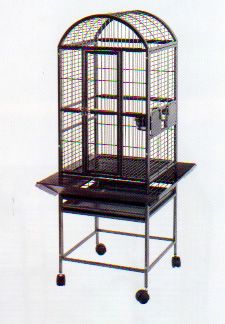
This is a 24" X 24" cage. It would fit an African Grey nicely. Or an Amazon. About the same size.,
It’s hard to give precise dimensions to the “proper” cage size for a given bird. Rather than say it’s such and thus by this and that, try to look at the bird’s environment as you would look at your own. The more spacious a room, the more you generally like it. You can put several chairs or a couch and loveseat in strategic locations so the room fits you, rather than you fitting the room.

This is kinda like a "finch's heaven." Finches like company. From 6 to 10 would be happy here. Lotta places to sit, some room to flit about. Movable, too.
I try to set up several “stations” in each cage for Caribe and Bravo. Different sized perches, different materials, a variety of locations with a natural flow from one to another that the bird can utilize. All connected in a way, although I look at them as individual “sites,” making up the whole.
There's some wood perches, couple of different sizes. They sleep on a concrete perch that is rough, like sandpaper, to keep talons sort of “filed down” and dull. Without those, the talons end up like needles that can be really uncomfortable when sitting on your hand or arm. And, I use perches of different sizes, so the birds exercise their feet and aren’t standing on the same sized perch all the time. High perches, low perches. Perches in front of a toy mounting spot. Perches for sleeping and napping.
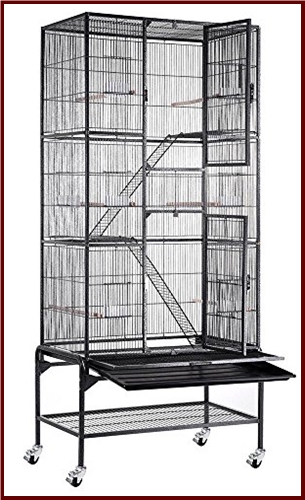
I see eight or ten cockatiels livin' large in this cage. Meets all their needs quite well. These are stackable and this could be three cages, or one big one.
Perch placement is critical. I'll sit in front of the cage and imagine “traffic patterns” inside that will move the bird from higher to lower, back to front, around the perimeter. I try to bring some continuity to the perch placement. Some perches go all the way from side to side. Others attach to the bars and extend into the cage a few inches. Goal is to provide a perch in key spots the bird would like to pause or stand.
In front of the food and water dishes, obviously. Within reach of a hanging toy. To provide a way up or down within the cage itself. It takes a little study to determine what might work. And, I tend to change the perch placement every now and then. Adds variety to their environment. I keep what works and I change what doesn’t. Easy to do. If there’s no poop beneath a given perch, it ain’t bein’ used!
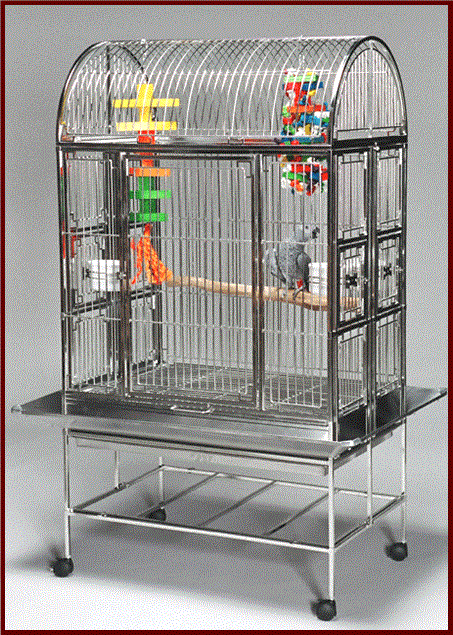
A couple of breeds kinda NEED stainless steel. Not this African Grey, but a large cockatoo...whole other story. Might want to add a lock on the door keyed to your fingerprints. They can pick combination locks!
Beyond cage size and perch placement, there is also the issue of TOYS! Birds MUST have toys. They chew on everything in the wild. It’s how they keep their beaks sharp but short. A bird that cannot chew develops a longer upper beak that can ultimately interfere with closing of the mouth, eating and drinking.
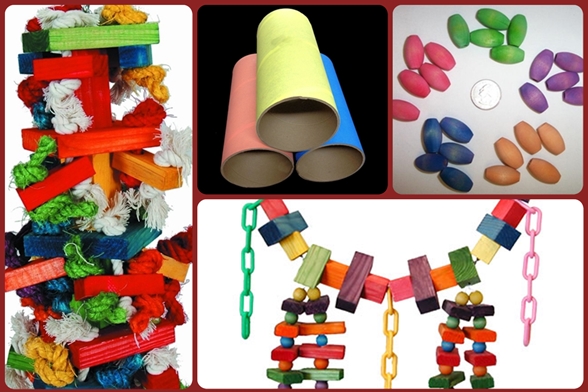
Toys are EXPENDABLE! They're created to be destroyed, utterly and totally, preferably.
So, an abundance of toys and ideally, there’s also a “lava rock” or pumice stone for them to clean and file their beak on. Birds HATE a dirty beak and you’ll notice they always clean their beak after eating. Especially with wet or sticky food. I give my guys a wet paper towel and they literally rip it to shreds and use the pieces to clean the interior of their mouths. Birds are fastidious creatures and they work hard at keeping themselves clean all the time.
There’s more to cages than you might think. Lots more. Please watch for Part Two soon. Hope you enjoyed this. I definitely enjoyed writing it.
Be talkin’ to you……………………..Webrydr
P.S. I'm fillin' a real small niche here. And, I'm a real small minnow in a big pond. Votes, resteems, promotion, suggestions, criticisms...anything you'd like to say or do is appreciated.
@webrydr, good basic info here. Thanks. Post is well thought out and well written. Upvoted